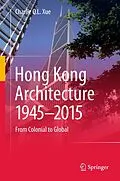"MTR's Kowloon Station project offered my firm the unique opportunity to contribute to a new type of fully integrated three dimensional transport mega-structure, conceived as a well-connected place for people to live, work and play.Through Charlie Xue's book, one can see how a compact city works and high density integrated development indicates a sustainable path for modern city making."
Sir Terry Farrell<, CBE, Principal, Farrells
"Well researched and refreshingly well structured, Charlie Xue's latest book comprehensively shows how Hong Kong's post-war urban architecture both tracks and symbolizes the former British colony's rise to success - a must read for architecture and culture buffs alike."
Peter G. Rowe, Raymond Garbe Professor of Architecture and Urban Design, Harvard University Distinguished Service Professor."An essential addition to the growing literature on Chinese architecture, the title of the book belies the full scope of Xue's extensive history. Covering Hong Kong's postwar transition from defeated colony to Pacific Age power house, Xue expertly traces the evolution of the city's ambitious and innovative programs of integrated high density urban design and infrastructure, as well as changing architectural fashions."
Professor Chris Abel, author of Architecture and Identity, Architecture, technology and process and The Extended Self.
Autorentext
Dr. Charlie Q. L. Xue has held teaching appointments in architecture at Jiaotong University, Shanghai; University of Texas, USA and City University of Hong Kong. Dr. Xue has nine books published including Building Practice in China (1999, 2009), Building a Revolution: Chinese Architecture Since 1980 (2006, 2009) and World Architecture in China (2010. His research papers were published in the international refereed journals like Journal of Architecture, Journal of Architecture and Planning Research, Urban Design International, Journal of Urban Design, Habitat International, Cities. His works are widely read and cited internationally. Xue's research focuses on architecture of the Greater China area and design strategies of high density environment.
Zusammenfassung
Hong Kong sets an extreme example of hyper-density living. MTR's Kowloon Station project offered my firm the unique opportunity to contribute to a new type of fully integrated three dimensional transport mega-structure, conceived as a well-connected place for people to live, work and play. Through Charlie Xue's book, one can see how a compact city works and high density integrated development indicates a sustainable path for modern city making.
Sir Terry Farrell, CBE, Principal, Farrells
"Well researched and refreshingly well structured, Charlie Xue's latest book comprehensively shows how Hong Kong's post-war urban architecture both tracks and symbolizes the former British colony's rise to success - a must read forarchitecture and culture buffs alike."
Peter G. Rowe, Raymond Garbe Professor of Architecture and Urban Design, Harvard University Distinguished Service Professor.
An essential addition to the growing literature on Chinese architecture, the title of the book belies the full scope of Xue's extensive history. Covering Hong Kong's postwar transition from defeated colony to Pacific Age power house, Xue expertly traces the evolution of the city's ambitious and innovative programs of integrated high density urban design and infrastructure, as well as changing architectural fashions. In a time when many Western governments have all but abandoned public housing programs, Xue's book is a timely reminder of what can be achieved.
Professor Chris Abel, author of Architecture and Identity, Architecture, technology and process and The Extended Self.<
Inhalt
